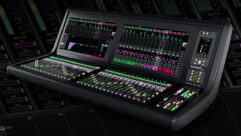Can the roof hold the rigging?No matter how good a job you do flying hardware, if the roof can’t hold it, you fall flat on your face and all your work lands on the ground.
Dec 20, 1996 12:00 PM,
By Bill ChristensonChristenson is a regional manager for Palos Verdes Engineering.
As contractors, we are often asked to add audio and visual arrays to buildings not originally designed for them. How to hang the arrays is well established, but where to hang them in regard to the building’s structure is not often discussed.
After the audio engineer determines the most effective placement of the loudspeaker array, the riggers and structural engineers must determine from what structural element the array should be hung.
LoadsThe local building codes, as a rule, do not regulate rigging. But the array’s added weight and its effect on the existing structure must conform to the code. The pressing question is whether roofs are strong enough to support new array loads without reinforcement. Riggers must assume that the answer is no.
All roofs are designed with a combination of dead and live loads. Dead loads consist of the weight of all the materials permanently attached to the structure. Live loads are the temporary weights imposed during the original construction of the roof and subsequent maintenance needs or weather conditions.
In most cases, any audio-visual array installed is intended to be a permanent part of the structure. The array, then, increases the dead load on the building, and further analysis must be performed. Depending on how closely the building was designed to its strength limits, reinforcing the existing framing may be necessary.
Occasionally, arrays are installed on a temporary basis. These loads are considered a part of the live load used in the original design of the building. In effect, the weights of temporary arrays have already been considered, and with smart placement, reinforcement is unnecessary.
No matter what the roof reinforcement needs are, it is important that the arrays be placed in such a way as to minimize the stress on the building.
Panelized roofsPanelized roofs present the most difficulty in retrofitting audio-visual arrays and, fortunately, are the least frequently encountered roof system. They are most often found in warehouses, industrial buildings and commercial buildings. Panelized roofs are divided up into large zones or panels, with glue-laminated girders supporting the edges of the panels. Solid sawn purlins span between the girders, and the spaces between the purlins are supported by smaller subpurlins. Figure 1 illustrates a schematic drawing of a typical panelized roof.
The girders, purlins and subpurlins maximize the spacing between the members. As a result, panelized roofs are extremely efficient and economical, but this makes adding loads to the existing framing very difficult without using reinforcement.
Most arrays are much too heavy to hang from the subpurlins and the purlins. Occasionally, they can be suspended from the glue-laminated girders, but this depends where along the girder the arrays are placed and how heavy they actually are. In most cases, it is advisable to ask a structural engineer for advice before rigging anything on these types of roofs.
When placing audio-visual arrays on panelized roofing systems:* Never attach pick-up points to the purlins or the subpurlins.* Reduce the load of the array by adding more pick-up points and then distributing them to several of the structural elements.* Try to place arrays close to the ends of the glue-laminated girders. This reduces the effects on the beam and transfers the load directly to the supporting walls and columns.
ArchesArch-framed roofs are used almost exclusively in churches and auditoria, but the relative high cost of arched roofs make them less popular today than they once were. Arches can be made out of any kind of material. Glue-laminated wood and steel are the most common, but concrete arches are occasionally encountered.
Arches work on the principle that vertical loads from the roof press down, creating an outward thrust at the base. Bent arches are normally pinned at the top of the arch to ease fabrication in the field and buttressed at the bottom to resist the thrust. (See Figure 2.)
A number of years ago we were asked to analyze a reinforced concrete arch in the Saint Paul’s Church in Los Angeles. The arches were spaced about 20 feet (6 m) apart and supported a conventional wood roof. The arch was 351/2 feet (10.8 m) high and 60 feet (18 m) wide. The church wanted to install an 800 pound (360 kg) array at the top of one of the arches. The calculations proved that the 800 pound loudspeaker increased the stress on the arch by a mere 4%. The arch was back checked, and we determined that the arch could safely support a 3,000 pound (914 kg) vertical load at the apex. The margin of overdesign for arches is usually much higher, in this case more than 15%, than it is for the panelized roof system, and thus fewer problems are expected.
Here are the guidelines for dealing with arched roof systems:* Distribute the array loads to two arches instead of one.* If possible, try not to hang arrays from the apex of the arches. The further down the arch the load is applied, the lower the induced stress will be.* Brackets are usually needed to attach the arrays to the arch. When bolting brackets to a wooden arch, design the brackets so the bolts are located toward the top of the arch.
TrussesTrussed roofs are the most common you will encounter. The technology of trusses has been around for centuries and is still fairly economical. These structures can span long distances and do not require intermediate supports. You will find trusses in churches, warehouses, sporting arenas and auditoria. Trusses are usually made of wood or steel or a combination of the two. When wood and steel are used in combination, the top and bottom chords are made out of wood, and the web members are made of steel.
We analyzed the wood trusses in the roof of the Hope Chapel in Hermosa Beach, CA, because the owners wanted to install a new lighting and loudspeaker system and wanted to know what additional total load the trusses could support. (See Figure 3.) The total design load on each truss was 69,110 pounds (31,099.5 kg), and the maximum additional load that could be applied was found to be 1,500 pounds (675 kg). Although the new load added just slightly more than 2% to the total load of the truss, many of the arrays that we have seen installed weigh less than that 2%. Therefore, based on this example, a medium-sized array could be placed on every truss without the need for reinforcement. In general, added array loads will not affect the performance of most large-scale trusses. Figure 3 illustrates which elements are in tension and which elements are in compression for the Hope Chapel trusses.
Trusses are made so all the vertical roof loads are transmitted to the elements in the truss in either tension (being pulled apart) or compression (being pushed together). The top chord is compressed, and the lower chord is pulled in tension. Web members connect the top and bottom chords and can be in either tension or compression. The points where the web members join either the top or bottom chords are called nodes.
Compression adds a measure of instability to a structure. As anyone standing on a soda can will attest, a small lateral force will cause the can to collapse. We do not see such dramatic failures in buildings, but the same principle applies. Because the top chords of trusses are always in compression and lateral forces generate instability, loads should never be hung from them. The individual elements of the truss are not designed as beams, so all loads applied to trusses should be attached at the nodes, where the forces are directly transmitted into the truss as tension and compression.
Some guidelines for attaching arrays to trusses:* Never connect an array to the top chord or web of a truss.* Make sure you always try to attach the arrays at the nodes of the trusses. The placement of loads between nodes creates bending stresses in the elements, which can lead to failure.* When connecting arrays to the trusses, use clamps instead of brackets that bolt through the bottom chord.
Roof structure generalitiesThe most important factor is to be conscientious and use common sense. Most situations, regardless of how unusual they may be, can be solved with a little thoughtfulness and inventiveness. If a situation arises in which you become uncomfortable, you probably have a good reason for it; do not feel afraid to ask for help from another professional. Remember that safe rigging is the most important consideration of everyone in the profession.










